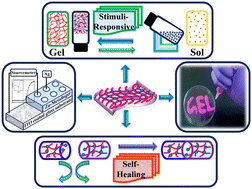Stimuli-responsive and self-healing supramolecular Zn(ii)–guanosine metal–organic gel for Schottky barrier diode application†
Abstract
Spontaneous formation of a supramolecular metal–organic hydrogel using unsubstituted guanosine as a ligand and Zn2+ ions is reported. Guanosine, in the presence of NaOH, self-assembled into a stable G-quadruplex structure, which underwent crosslinking through Zn2+ ions to afford a stable hydrogel. The gel has been characterized using several spectroscopic as well as microscopic studies. The hydrogel demonstrated excellent stimuli responsiveness towards various chemicals and pH. Furthermore, the gel exhibited intrinsic thixotropic behavior and showed self-healing and injectable properties. The optical properties of the Zn–guanosine metallo-hydrogel suggested a semiconducting nature of the gel, which has been exploited for fabricating a thin film device based on a Schottky diode interface between metal and a semiconductor. The fabricated device shows excellent charge transport characteristics and linear rectifying behavior. The findings are likely to pave the way for newer research in the area of soft electronic devices fabricated using materials synthesized by employing simple biomolecules.



 Please wait while we load your content...
Please wait while we load your content...